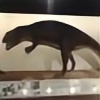HOME | DD
 Trendorman — COTW#121: Bunyip
Trendorman — COTW#121: Bunyip

#australia #bunyip #cryptid #cryptozoology #dinosaur
Published: 2017-04-10 20:14:04 +0000 UTC; Views: 3234; Favourites: 59; Downloads: 5
Redirect to original
Description
The Bunyip (translated in Aboriginal Australian to mean devil or evil spirit), also known as the Kianpraty, is a creature of Aboriginal mythology. It lives in the swamps, billabongs, creeks, riverbeds and waterholes of Australia. Bunyip in the Wemba-Wemba language means "devil" or "Evil spirit". the Bunyip has many descriptions. Some say it has a dog-like face, dark fur, a horse-like tail, flippers, a walrus-like tusks, and a duck-like bill. Others think the creature has an appearance similar to a snake with a man and a beard. Some even think that the bunyip is actually the prehistoric marsupial, Diprotodon australis, that managed to escape extinction.This creature is described to gobble up children and livestock in several Aboriginal bedtime stories if they come to close to the water's edge. One legend says that a man named Bunyip broke the Rainbow Serpent's greatest law by eating his totem animal. Banished by the good spirit, Biami, the man became an evil spirit that lured tribesmen and their livestock into the water so he could eat all of them. The Bunyip is also said to prey upon the women and children of aboriginal tribes during the night.
One of the first recorded accounts of the bunyip took place in 1818, when James Meehan and explorer Hamilton Hume both found enormous bones in Lake Bathurst, located in New South Wales of Australia. They described the creature similar to a manatee or a hippopotamus.
In the mid-1830s, George Rankin discovered fossilized bones in the Wellington Caves located in New South Wales of Australia, later to be followed by explorer Thomas Mitchell. British anatomist Sir Richard Owen described the bones to be the remains of prehistoric marsupial Diprodoton.
On July of 1845, the Geelong Advertiser describes the Bunyip in great detail. It was also the first recorded use of the term "Bunyip":
"The Bunyip, then, is represented as uniting the characteristics of a bird and of an alligator. It has a head resembling an emu, with a long bill, at the extremity of which is a transverse projection on each side, with serrated edges like the bone of the stingray. Its body and legs partake of the nature of the alligator. The hind legs are remarkably thick and strong, and the fore legs are much longer, but still of great strength. The extremities are furnished with long claws, but the blacks say its usual method of killing its prey is by hugging it to death. When in the water it swims like a frog, and when on shore it walks on its hind legs with its head erect, in which position it measures twelve or thirteen feet in height."
In 1847, a strange skull was found in the Murrumbidgee River near Balranald in New South Wales. It was later put on exhibition at the Australian Museum in Sydney. The skull was later proven to only be the cranium of a disfigured horse or calf.
Related content
Comments: 15

👍: 0 ⏩: 1

👍: 0 ⏩: 0

That is awesome. My favorite interpretation of the creature. Love the cassowary features.
👍: 0 ⏩: 1

Thank you! I think it may be the first time it has been done!
👍: 0 ⏩: 0

Interesting way of interpreting all the conflicting depictions of the bunyip. Me, I just think that it's multiple creatures.
👍: 0 ⏩: 1

I actually think its a Diprotodon
👍: 0 ⏩: 0

Kinda reminds me of a Therizinosaur look wise
👍: 0 ⏩: 1

Or, a water Adapted Ornithopod!
👍: 0 ⏩: 1

That for some reason evolved to be more upright and lost the tail, those are the dinosaurs like Hadrosaurs right, Ornithopods?
👍: 0 ⏩: 1

Perhaps they evolved to walk through deep water so it stood up right and thick heavy legs so it doesn't fall over because of water current
👍: 0 ⏩: 1

But why would it loose the tail?
👍: 0 ⏩: 1

So the current doesn't catch it
👍: 0 ⏩: 1

👍: 0 ⏩: 1

👍: 1 ⏩: 0


















